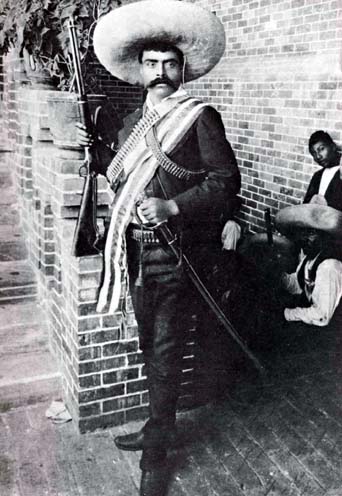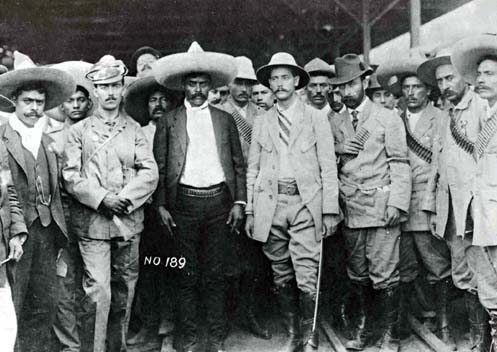©‘Zapata Armado de Lata!‘by Artist Shalak, Brazil, Oct 2011
 Emiliano Zapata was born in Anenecuilco, in the Mexican state of Morelos, just south of Mexico City. It was in this region that Zapata would spend his life. His career would be dedicated to the people of the region, and it was in Morelos that he would make the supreme sacrifice for his beliefs and for the people he so loved.
Emiliano Zapata was born in Anenecuilco, in the Mexican state of Morelos, just south of Mexico City. It was in this region that Zapata would spend his life. His career would be dedicated to the people of the region, and it was in Morelos that he would make the supreme sacrifice for his beliefs and for the people he so loved.
Zapata lost his father when he was 17 years old (in 1896), and thus his education was cut short. He took up work as a horse trainer to support his family, his mother and nine siblings. One of his brothers, Eulalio, would join him in the revolution. Zapata’s main cause was the return of stolen land to its rightful owners, the peasants of Morelos. It is said that he kept the deeds of the peasant families in a tin box he had with him always. Over time, the Spanish deeds that proved peasant ownership of the lands had been ignored and even rescinded. The hacendados (hacienda owners) had taken over the land to build money-making haciendas, which used the labor of those who truly owned the land, to harvest and manufacture sugar cane and other crops for export. The sugar-producing haciendas of Morelos were notorious for bad working conditions and the workers were virtual slaves under the whips of the hacendados’ foremen.
In 1909, around the time of his 30th birthday, Zapata was officially put in charge of the village council and was thus officially responsible for the welfare of the people of Anenecuilco. Zapata protected his village with the kind of care and attention to detail he would have given to protecting his own family.
Zapata initially supported the anti-reelectionist movement of Francisco I. Madero, and formed the Liberation Army of the South to fight for the Maderista revolt. But once Madero became president, Zapata quickly became disenchanted. He realized that Madero would not institute true agrarian reform. In fact, Madero was from a family of rich land-owners, and while in many ways his heart was in the right place, he was not about to expropriate the lands of members of his own class. Therefore, just around the time Madero was sworn in as president, Zapata and his men issued the Plan de Ayala (1911), in which Zapata broke with the president. Madero sent troops south to rout the Zapatistas. Zapata joined forces with another former Maderista, Pascual Orozco, who was based in the north. Orozco was a disgruntled former general who had fought for Madero alongside Francisco Villa. Orozco, with the support of Zapata, launched an uprising against Madero in March, 1912. It was soon put down by Madero’s general, Victoriano Huerta.
Zapata was a hero to the families in his region, although he and his men continuously drew the wrath of the federal government down upon Morelos. The Zapatistas fought against a series of federal agents sent to destroy them, but none was more brutal than Juvencio Robles. When Madero was overthrown in a coup engineered by Victoriano Huerta (himself a brutal dictator), Zapata declared war against Huerta. Huerta responded by declaring every poor person in Morelos a Zapatista. He brought Juvencio Robles back to carry out a “slash and burn” policy to, in Huerta’s words, “depopulate the state.” It was tantamount to genocide.
Once again, Zapata and his men defended their people at great cost, and rallied around Venustiano Carranza‘s Plan de Guadalupe (April, 1913) – which created the Constitutionalist rebellion, designed to defeat Huerta and strip him of power. But Carranza, too, would prove to be a disappointment. After Huerta’s defeat, and Carranza’s seizing of de facto power in Mexico (he would not officially become president until 1917), a convention was called among the various revolutionary factions. They met in October, 1914 in the town of Aguas Calientes, to determine what could be done about Carranza’s lack of legitimacy. Although Zapata would not attend the meeting, he and Villa met that December, in the village of Xochimilco. The two generals, much loved by the common people, then rode with their troops into Mexico City, taking control over the capital and capturing the imagination of the masses. Unfortunately, unwilling to rule Mexico, they each soon returned home – Zapata south to Morelos and Villa north to Chihuahua. Carranza retained power.
As president, Carranza decided he had to eliminate Zapata as a threat. An intricate plot was devised by Carranza’s right-hand man, Pablo Gonzalez, by which a federal general named Guajardo would pretend to defect to the Zapatistas. He would work methodically to prove himself anxious to leave Carranza’s army and join Zapata. Guajardo staged a rout against other federal troops, sacrificing scores of men for what was essentially a “performance” to gain credibility with Zapata. Finally, a deal was sealed. Zapata and Guajardo were to meet to sign an agreement to join forces at the hacienda of Chinameca. In the early afternoon of April 10, 1919, Zapata rode into the hacienda with just a handful of his men, indicating to the rest of them that they should wait some distance away. A bugle sounded four times, and when Guajardo’s soldiers were to deliver a military salute to Zapata, they instead pointed their rifles at him and his small contingent. The men waiting for him heard the two volleys, and saw his now-riderless horse run toward them, covered in blood. They knew their leader had been slain.
Soon after, signs containing one of Zapata’s mottos began appearing around Morelos, as both a memorial and an inspiration for his men to continue the fight: “It is better to die on your feet than to live on your knees.”
Read more about the Zapatistas https://www.iamhiphopmagazine.com/knowledge-session-who-are-the-zapatistas/
Read more about Mexico http://www.pbs.org/itvs/storm-that-swept-mexico/
Emiliano Zapata’s Funeral
[youtube]http://youtu.be/-5cmEIMv-f0[/youtube]
Gata Malandra
Latest posts by Gata Malandra (see all)
- Event: World Crew Battle UK By Swatch — October 11, 2017
- Knowledge Session: Who Was Manco Inca? — May 4, 2017
- Video + Letra: Illmani ‘Saber es Poder’ — February 3, 2017
